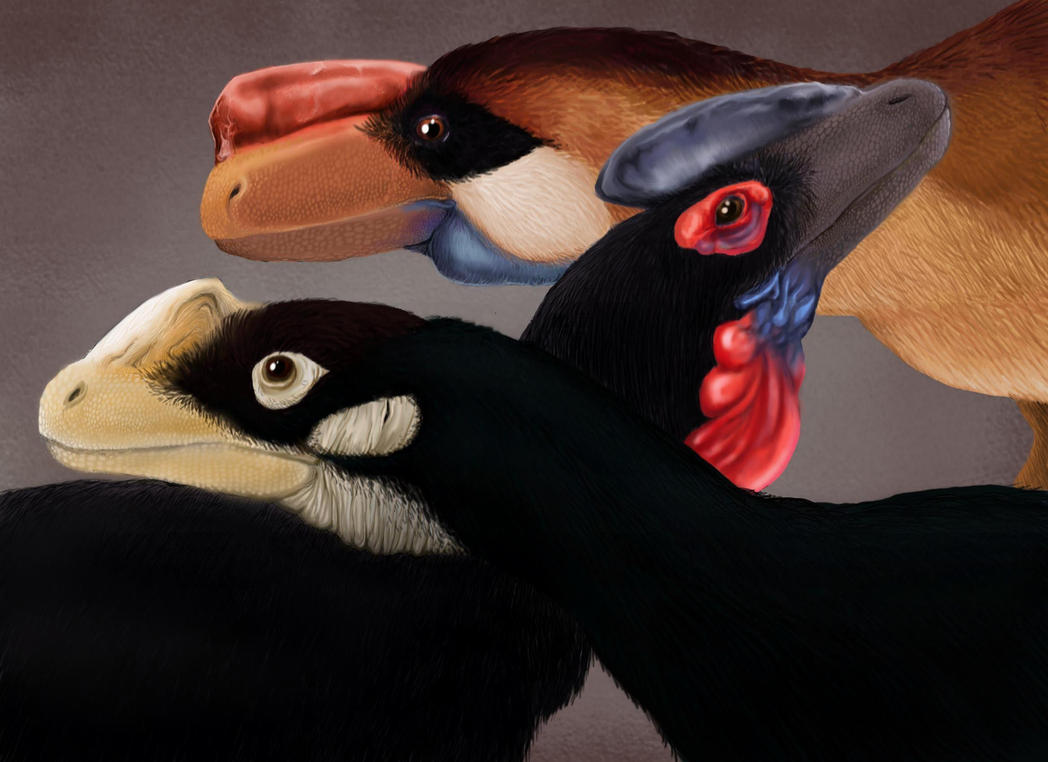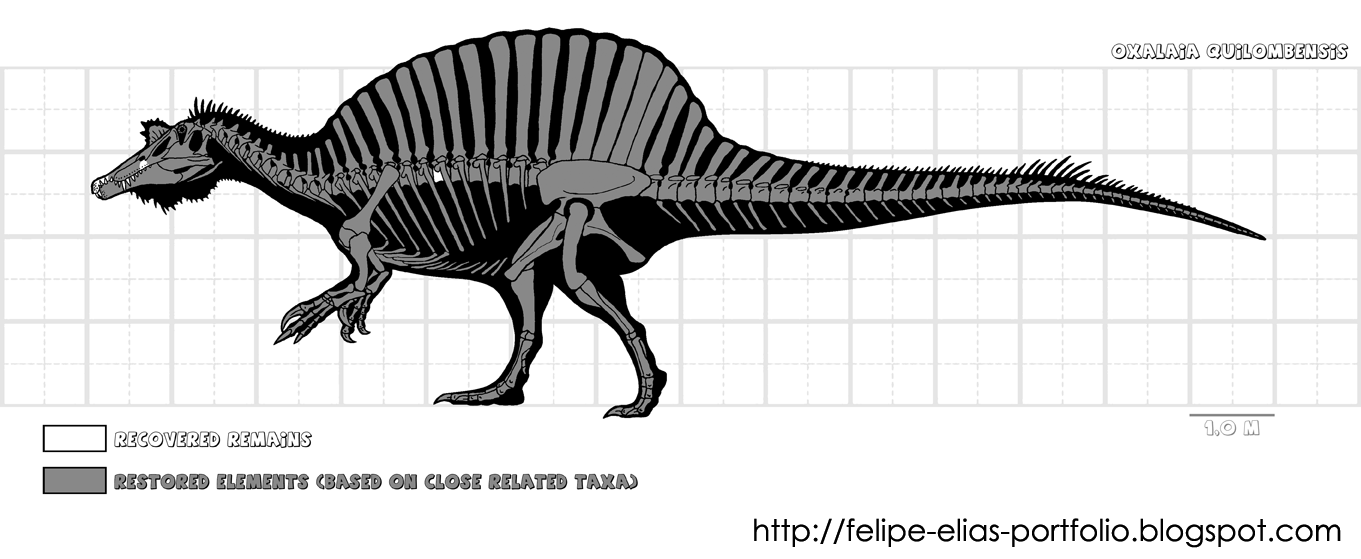gigadino96
Junior Member
  Vi ravviso, o luoghi ameni
Vi ravviso, o luoghi ameni
Posts: 226 
|
Post by gigadino96 on Jun 20, 2013 23:28:28 GMT 5

Profile
Name: Oxalaia quilombensisLength: 11 meters Mass: 5 tons When: Late Cretaceous, Cenomanian, about 100 milion years ago Where: South America Classification: Animalia, Chordata, Reptilia, Saurischia, Theropoda, Megalosauroidae, Spinosauridae, Spinosaurinae, Oxalaia, Oxalaia quilombensisOxalaia quilombensis is a carnivorous dinosaur belonging to spinosauridi. He lived at the beginning of the Upper Cretaceous (Cenomanian, about 100 million years ago) and its fossil remains have been found in Brazil. All that is known of this dinosaur are a couple of premascelle melted and left jaw fragment belonging to an individual very large. A comparison with the fossils of similar animals (Irritator, Spinosaurus) is supposed to Oxalaia could reach a length of about 11 meters and a weight between of 5 tons. Like all the Spinosaurus, Oxalaia had a long, low skull, different from that of many large carnivorous dinosaurs. Was present a space (diastema) between the front teeth in the tip of the snout and the rear ones, although shorter than that present in Spinosaurus. The premascella of Oxalaia possessed a ventral crossed by several folds. The teeth were similar to those of the other Spinosaurus: a section rounded or slightly flattened, with no jagged hull and slightly curved. Since the best-known genus of spinosauridi (Spinosaurus) was equipped with long dorsal vertebrae that perhaps formed a sort of veil, you may also Oxalaia were equipped with such a structure. Oxalaia was described for the first time in 2011, on the basis of fossils found in the formation Alcântara, on Cajual in the Brazilian state of Maranhão. The fossils were discovered for the first time in 2004, and included several other isolated teeth attributable to spinosauridi. It is assumed that Oxalaia was closely related to Spinosaurus, who lived in Africa more or less the same time and considered the largest carnivorous dinosaur. In Brazil, it was found also another Spinosaurus, Irritator, coming from land a little more ancient and smaller. Oxalaia The generic name refers to the divine figure of African origin Oxala, while the specific epithet refers to quilombensis Quilombos, a Quilombo was a community formed by African slaves who fled the plantations where they were prisoners at the time of slavery in Brazil. Both names refer to the close connections between the Brazilian Spinosaurus and its African relatives. |
|
gigadino96
Junior Member
  Vi ravviso, o luoghi ameni
Vi ravviso, o luoghi ameni
Posts: 226 
|
Post by gigadino96 on Jun 20, 2013 23:58:51 GMT 5
|
|
Derdadort
Junior Member
  Excavating rocks and watching birds
Excavating rocks and watching birds
Posts: 267 
|
Post by Derdadort on Jul 21, 2013 18:22:13 GMT 5
Kellner et al. declare the length of the holotype with 12 to 14m, so I would suggest 13m for Oxalaia.
|
|
|
|
Post by theropod on Jul 21, 2013 19:19:30 GMT 5
The size is a problem in this case. A while ago I made this based on the published scalebars:  Feel free to deduce comparative figures from this. to me it appeared the specimen was likely only marginally bigger than Suchomimus. If correct, it seems it is a good deal smaller than Spinosaurus. Other spinosaurs are more problematic, because baryonychines have a different rostral shape than spinosaurines, and no consensus has been reached on scaling between them. Irritator unfortunately lacks the rostrum. |
|
Derdadort
Junior Member
  Excavating rocks and watching birds
Excavating rocks and watching birds
Posts: 267 
|
Post by Derdadort on Jul 21, 2013 20:43:01 GMT 5
Maybe gigadino96 has some sources (do you?), he also links to Kellner et al., but there are only those 12 to 14 metres mentioned. It's indeed a bit strange. I read the paper two or three weeks ago and also wondered how they estimated total lenght and weight. But it was the only information I found.
|
|
|
|
Post by theropod on Jul 21, 2013 21:48:24 GMT 5
The skull was for some reason estimated at 1,35m.
as said, I'm really not sure of anything in this regard, and I haven't spent a lot of time trying to make a rigorous estimate. But it seems doubful (keep in mind the skull-lenghht estimation for the portuguese Torvosaurus maxilla...).
There are no sources apart for the description and the entry in the theropod database.
|
|
blaze
Paleo-artist   
Posts: 766
|
Post by blaze on Jul 22, 2013 1:58:59 GMT 5
Kellner et al. made the skull and 12-14m estimates based solely on MSNM V4047 and Dal Sasso's estimates for it, I don't have comparative measurements at hand but I took your image theropod and scaled down the rostrum of Spinosaurus to 77% the size and it seems to match that of Oxalaia, which implies that's how they got 135cm for its skull, it's dimensions are 77% that of MSNM V4047 which was estimated to have a skull length of 175cm by Dal Sasso (175*0.77 = 135), the total length estimates, accordingly, are 77% of those presented by Dal Sasso (16-18m * 0.77 = ~12-14m).
Premaxilla to quadratojugal will, based on Hartman's Spinosaurus, be around ~126cm and total length, again, based on Hartman, will be 11.7m, Suchomimus sized, the sweet spot appears to be between 11-12m.
|
|
gigadino96
Junior Member
  Vi ravviso, o luoghi ameni
Vi ravviso, o luoghi ameni
Posts: 226 
|
Post by gigadino96 on Jul 25, 2013 19:32:37 GMT 5
Maybe gigadino96 has some sources (do you?), he also links to Kellner et al., but there are only those 12 to 14 metres mentioned. It's indeed a bit strange. I read the paper two or three weeks ago and also wondered how they estimated total lenght and weight. But it was the only information I found. Yep, read the Holtz Genus List, Oxalaia is elencated at 11 meters. |
|
|
|
Post by creature386 on Aug 3, 2013 17:44:27 GMT 5
The Holtz Genus list shows numbers for many different dinosaurs, I believe a source investigating Oxalaia in detail would be a better source.
|
|
|
|
Post by dinosauria101 on May 15, 2019 20:50:40 GMT 5
|
|











